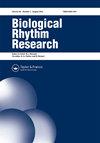Induction of spawning under artificial moonlight in the honeycomb grouper Epinephelus merra, a lunar-synchronized spawner
IF 0.9
4区 生物学
Q3 BIOLOGY
引用次数: 0
Abstract
ABSTRACT In the reproductive season, lunar-synchronized fish spawn during species-specific moon phases. It remains unknown how they perceive cues from the moon for initiating gonadal development and subsequent spawning. We hypothesized that fish use moonlight to synchronize reproductive events. Using the honeycomb grouper Epinephelus merra, a tropical Serranidae, spawns around the time of the full moon, we report the successful induction of spawning in this species by controlling light condition at night. Following 3 months of acclimatization under long days (14:10) at 28 ± 1.0°C, mature fish were reared under an artificial full (experimental group) or new (controls) moon during scotophase. Rearing fish under these conditions for 1 month resulted in successful spawning in the experimental group between 21h00 and 01h30. Similar results were obtained when control fish were subdivided into artificial full and new moon groups and reared for an additional month. Fish in the experimental group had a high gonadosomatic index and abundant yolk-laden oocytes in the ovary. Therefore, moonlight triggers gonadal development and subsequent spawning in lunar-synchronized fish with a full-moon preference.在人造月光下诱导蜂窝石斑鱼产卵
在繁殖季节,与月亮同步的鱼类在特定物种的月相产卵。目前尚不清楚它们是如何感知来自月球的信号来启动性腺发育和随后的产卵的。我们假设鱼类利用月光来同步生殖活动。利用热带石斑鱼科的蜂窝石斑鱼Epinephelus merra在满月前后产卵,我们报告了通过控制夜间光照条件成功诱导该物种产卵的方法。在28±1.0℃条件下长日(14:10)驯化3个月后,将成熟鱼饲养在人工满月(试验组)或新月(对照组)下。在这些条件下饲养鱼1个月,实验组在21时00分至11时30分之间成功产卵。将对照鱼再分为人工满月组和人工新月组,再饲养一个月,也得到了类似的结果。试验组鱼具有较高的促性腺指数,卵巢内有丰富的含蛋黄卵母细胞。因此,月光触发了与月亮同步的鱼的性腺发育和随后的产卵,它们对满月有偏好。
本文章由计算机程序翻译,如有差异,请以英文原文为准。
求助全文
约1分钟内获得全文
求助全文
来源期刊

Biological Rhythm Research
生物-生理学
CiteScore
3.00
自引率
9.10%
发文量
34
审稿时长
6-12 weeks
期刊介绍:
The principal aim of Biological Rhythm Research is to cover any aspect of research into the broad topic of biological rhythms. The area covered can range from studies at the genetic or molecular level to those of behavioural or clinical topics. It can also include ultradian, circadian, infradian or annual rhythms. In this way, the Editorial Board tries to stimulate interdisciplinary rhythm research. Such an aim reflects not only the similarity of the methods used in different fields of chronobiology, but also the fact that many influences that exert controlling or masking effects are common. Amongst the controlling factors, attention is paid to the effects of climate change on living organisms. So, papers dealing with biometeorological aspects can also be submitted.
The Journal publishes original scientific research papers, review papers, short notes on research in progress, book reviews and summaries of activities, symposia and congresses of national and international organizations dealing with rhythmic phenomena.
 求助内容:
求助内容: 应助结果提醒方式:
应助结果提醒方式:


